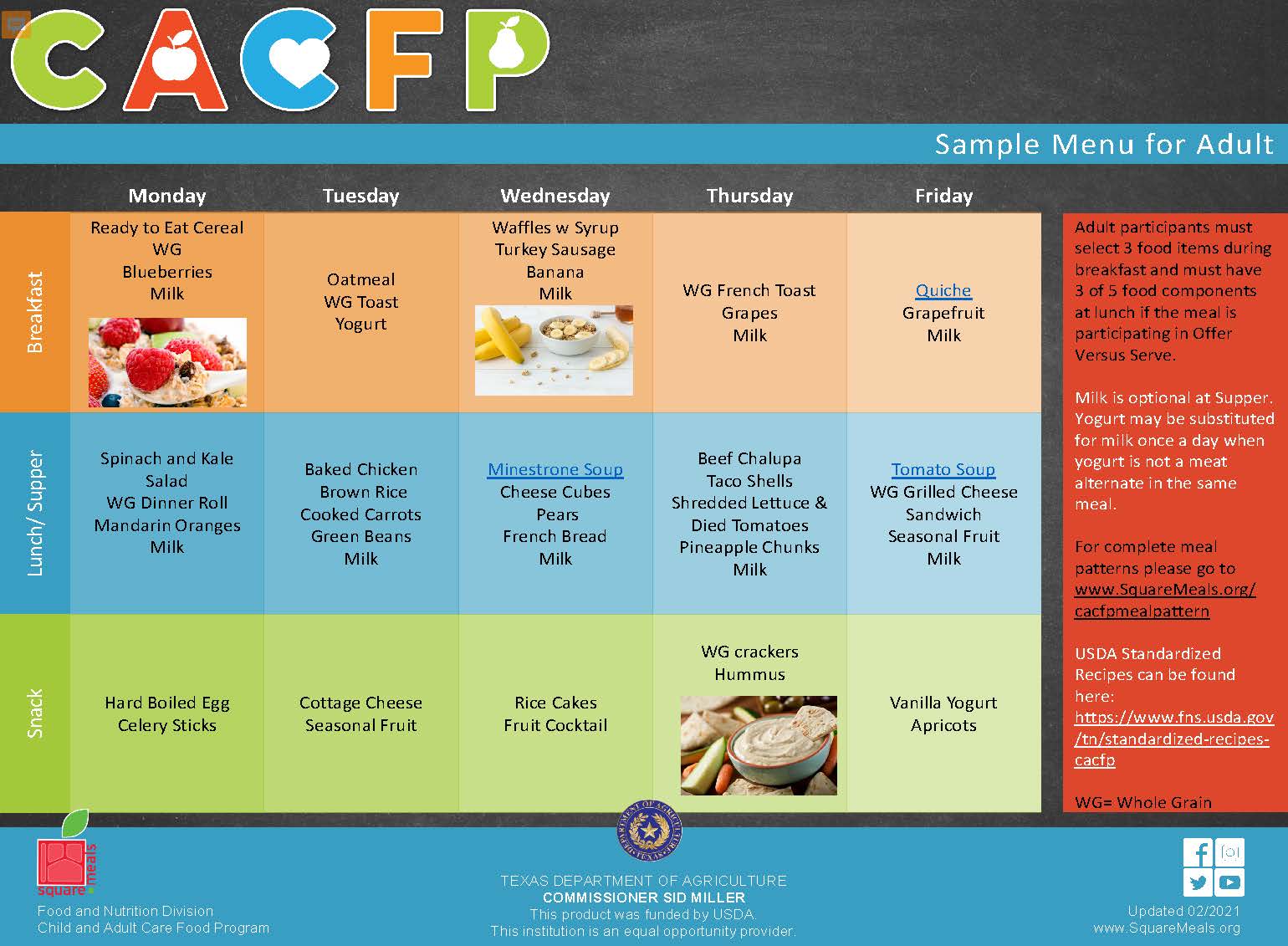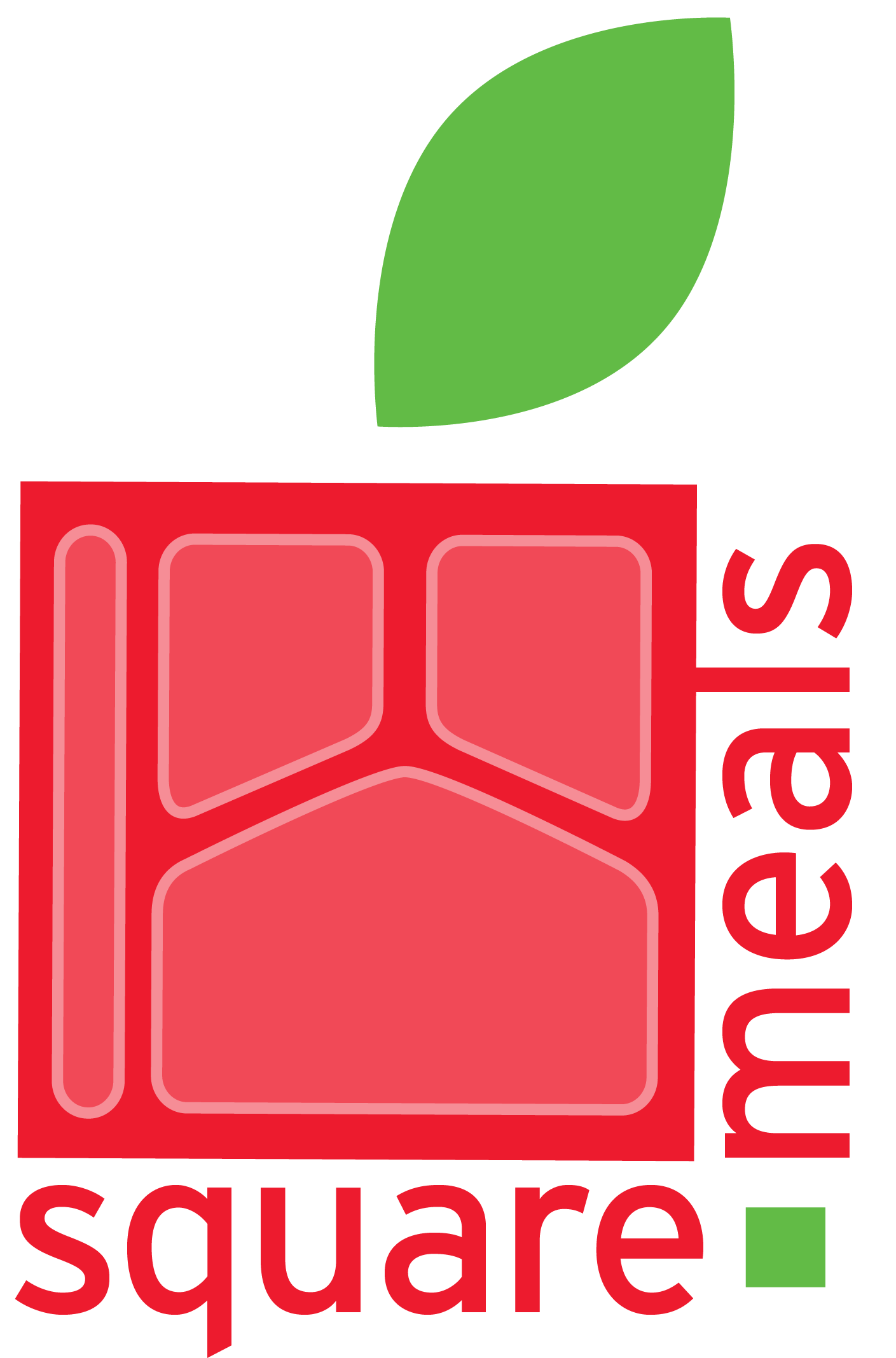|
|
|
Meal Appeal for Adults
|
|

Click the image to download the Healthy Tips for Adult Meals resource!
|

Click the image to download Sample Menus!
|
Use the + buttons below to expand each section.
Center Gardens

Center and home gardens can serve seniors throughout the state of Texas by encouraging adult day care centers to buy local produce to increase the appeal, acceptability, and nutrition value of the meals and snacks they serve through CACFP. Seniors learn the joy of gardening with hands-on activities that provide interaction with other Senior adults and caregivers.
Benefits to Seniors
- Nourishment – buying local and on-site gardening produces nutrient-dense foods and ingredients that contribute to a balanced diet.
- Physical and Mental Engagement — spending time in nature can be good for a person’s entire well-being. Gardening requires physical strength and mental patience to wait for the plants to grow. Occupational and physical therapy can be performed through gardening.
- Cost-efficiency — growing your own food and buying locally can be a cost saver.
- Lifelong Learning – gardening teaches best practices, time of day to water, how often to water and what types of plants need unique attention. Seniors learn about the health benefits of eating locally grown food, as well as how it’s better for the environment and more satisfying to their taste buds.
- Sense of Accomplishment - gardening lets seniors watch something they planted come to life. For an older adult gardening delivers a sense of meaning and accomplishment.
Always consult your doctor before engaging in physical activity to determine the level of exercise appropriate for you. Have day care staff perform the laborious tasks and have the senior residents manage the lighter garden upkeep.
Download this handy 2-page resource How to Build a Raised Edible Garden to get started!
Dining Experience

Make Mealtime Enjoyable
Create a nurturing environment for your senior population.

Nutrition habits become more important and vital to the elderly’s overall health. When the elderly eat nutritious meals, they can maintain sharp minds and alertness, increase their energy levels and improve quality of life. A pleasant environment improves the amount and types of foods eaten.
- Flowers on the table or eating outside in nice weather improves appetite and food consumption.
- A polite, well-trained staff adds pleasure to the dining experience.
- The elderly become more health-conscious when they eat meals with others.
- Introduce ‘theme days’ in the dining room for example, Valentine’s Day, a harvest festival (perhaps produce grown by the seniors), a birthday party (celebrated one day each month) friendship or dessert day.
The atmosphere of the dining area is an important factor in encouraging participants to eat. Some suggestions to improve the senior dining experience include:
- Choose paint colors wisely using light, solid colors on the walls of the dining room
- Use contrasting solid colors for placemats, napkins, and dishes. This helps the participant locate the utensils and dishes.
- Simple colorful centerpieces will create a homelike setting.
- Keep noise from the kitchen to a minimum.
- Soft background music is pleasant for those with normal hearing, but may sound like noise or static to the hearing impaired.
- Provide each participant with a large napkin that can be put in the lap or tucked under the chin, or with two napkins – one for the lap and one to wipe the mouth. Some Seniors find bibs or aprons offensive – be considerate of their needs and preferences.
- At mealtimes, have day care staff sit with participants who struggle to eat. Have the staff offer verbal, physical and emotional support to these participants to increase food intake.
- A standard dining room chair with arm rests for support provides the best position for most adults to eat.
- Maintain a room temperature that is comfortable to the participants. If the dining area is too cool, too stuffy, or too hot, the participants will not enjoy the meal.
- Be aware of drafts and blowing air vents.
- Offer to bring a sweater or lap blanket for a participant who is cold.
Menus, Recipes and Cookbooks

Whole Grain-Rich Products

What is a Whole Grain?
The term whole grain-rich is not an industry recognized term. It is used in the federal child nutrition programs to mean at least 50% of the grain item is whole grain and the rest is enriched grain, a bran or a germ. The CACFP requires that at least one grain serving per day, across all eating occasions, is whole grain-rich. Refer to these resources for recommended cooking times and best practices when preparing whole grain-rich pasta, which need more cooking time. All are suitable for display in the kitchen for quick reference during meal preparation.
Whole Grain-Rich Pasta Cooking Resources
Additional Resources

|
|
|
|
|
|
|
|
|
|
|
Assistance available in English and Spanish. Please call 877-TEX-MEAL (877-839-6325) for help. Additional translations services available as well.
|
|
In accordance with federal civil rights law and U.S. Department of Agriculture (USDA) civil rights regulations and policies, this institution is prohibited from discriminating on the basis of race, color, national origin, sex, disability, age, or reprisal or retaliation for prior civil rights activity.
Program information may be made available in languages other than English. Persons with disabilities who require alternative means of communication to obtain program information (e.g., Braille, large print, audiotape, American Sign Language), should contact the responsible state or local agency that administers the program or USDA’s TARGET Center at (202) 720-2600 (voice and TTY) or contact USDA through the Federal Relay Service at (800) 877-8339.
To file a program discrimination complaint, a Complainant should complete a Form AD-3027, USDA Program Discrimination Complaint Form which can be obtained online at: https://www.usda.gov/sites/default/files/documents/ad-3027.pdf, from any USDA office, by calling (866) 632-9992, or by writing a letter addressed to USDA. The letter must contain the complainant’s name, address, telephone number, and a written description of the alleged discriminatory action in sufficient detail to inform the Assistant Secretary for Civil Rights (ASCR) about the nature and date of an alleged civil rights violation. The completed AD-3027 form or letter must be submitted to USDA by:
|
|
1. Mail:
U.S. Department of Agriculture
Office of the Assistant Secretary for Civil Rights
1400 Independence Avenue, SW
Washington, D.C. 20250-9410; or
2. Fax: (833) 256-1665 or (202) 690-7442; or
|
|
| This institution is an equal opportunity provider. |
 |

|
|
|